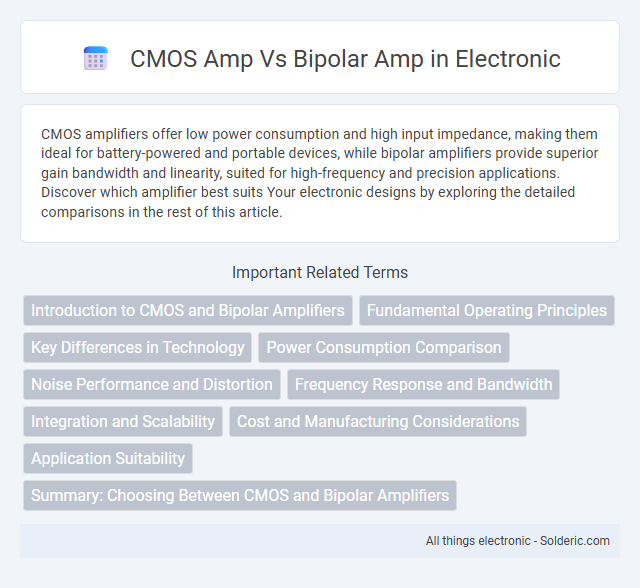CMOS amplifiers offer low power consumption and high input impedance, making them ideal for battery-powered and portable devices, while bipolar amplifiers provide superior gain bandwidth and linearity, suited for high-frequency and precision applications. Discover which amplifier best suits Your electronic designs by exploring the detailed comparisons in the rest of this article.
Comparison Table
| Feature | CMOS Amplifier | Bipolar Amplifier |
|---|---|---|
| Technology | Complementary Metal-Oxide-Semiconductor | Bipolar Junction Transistor (BJT) |
| Power Consumption | Low power dissipation | Higher power consumption |
| Input Impedance | High input impedance | Low input impedance |
| Noise Performance | Moderate noise | Low noise (better for low-noise applications) |
| Speed (Bandwidth) | Moderate speed | High speed and bandwidth |
| Linearity | Good linearity | Better linearity |
| Cost | Lower manufacturing cost | Higher manufacturing cost |
| Integration | Highly integrable on CMOS ICs | Less suitable for dense integration |
| Temperature Stability | Stable across temperature ranges | More temperature sensitive |
Introduction to CMOS and Bipolar Amplifiers
CMOS amplifiers utilize complementary metal-oxide-semiconductor technology, leveraging both NMOS and PMOS transistors to achieve low power consumption and high input impedance, making them ideal for integrated circuits. Bipolar amplifiers, based on bipolar junction transistors (BJTs), provide high gain and fast response times due to the injection and control of minority carriers in their operation. The fundamental difference lies in CMOS devices being voltage-driven with efficient switching characteristics, while bipolar amplifiers are current-driven, offering superior linearity and low noise performance for analog signal amplification.
Fundamental Operating Principles
CMOS amplifiers utilize complementary pairs of MOSFETs to achieve high input impedance and low power consumption, making them ideal for battery-powered devices. Bipolar amplifiers rely on bipolar junction transistors (BJTs) that offer higher transconductance and faster switching speeds, resulting in greater gain and bandwidth. Your choice depends on whether power efficiency or signal performance is the priority in your application.
Key Differences in Technology
CMOS amplifiers utilize complementary metal-oxide-semiconductor technology, providing low power consumption and high input impedance, while bipolar amplifiers rely on bipolar junction transistors known for higher gain and faster switching speeds. CMOS amps excel in integrated circuit applications due to their scalability and noise performance, whereas bipolar amplifiers offer superior linearity and bandwidth for analog signal processing. Your choice between CMOS and bipolar amplifiers hinges on specific requirements like power efficiency, frequency response, and signal distortion tolerance.
Power Consumption Comparison
CMOS amplifiers exhibit significantly lower power consumption compared to bipolar amplifiers due to their high input impedance and low static current draw, making them ideal for battery-powered devices. Bipolar amplifiers, with their continuous biasing currents, generally consume more power but offer higher transconductance and faster switching speeds. The power efficiency of CMOS technology often results in reduced thermal dissipation, enabling longer device operation in portable applications.
Noise Performance and Distortion
CMOS amplifiers typically exhibit lower noise performance at low frequencies due to their high input impedance and reduced flicker noise, making them suitable for precision applications. Bipolar amplifiers generate less distortion and offer better linearity, especially at higher frequencies, due to their transconductance properties and higher transconductance gain. Your choice between CMOS and Bipolar amplifiers should consider the specific requirements for noise sensitivity and distortion tolerance in your circuit design.
Frequency Response and Bandwidth
CMOS amplifiers generally exhibit a wider bandwidth due to their lower parasitic capacitances, enabling better high-frequency performance compared to bipolar amplifiers. Bipolar amplifiers provide superior gain at lower frequencies but their frequency response rapidly decreases as frequency increases due to higher junction capacitances. The choice between CMOS and bipolar amplifiers depends on the specific application requirements for frequency response and bandwidth optimization.
Integration and Scalability
CMOS amplifiers offer superior integration capabilities due to their compatibility with standard CMOS processes, enabling seamless incorporation into complex IC designs and achieving high scalability for large-scale production. In contrast, bipolar amplifiers, while providing higher gain and better noise performance, face challenges in integration and scalability because they require specialized manufacturing steps and larger chip area. Consequently, CMOS amplifiers dominate applications demanding high-density integration and cost-effective scalability, especially in modern digital and mixed-signal systems.
Cost and Manufacturing Considerations
CMOS amplifiers are generally more cost-effective due to their compatibility with standard CMOS fabrication processes, enabling high-volume production and integration with digital circuits, which reduces overall manufacturing expenses. Bipolar amplifiers require specialized fabrication techniques, leading to higher material and processing costs, making them less economical for large-scale production. The scalability and lower power consumption of CMOS amplifiers also contribute to their preference in cost-sensitive applications.
Application Suitability
CMOS amplifiers excel in low-power, high-density integrated circuits, making them ideal for portable and battery-operated devices where energy efficiency is critical. Bipolar amplifiers offer superior gain and bandwidth, suited for high-frequency and high-precision analog applications like RF circuits and instrumentation amplifiers. The choice between CMOS and bipolar amplifiers depends on the required performance metrics such as power consumption, speed, and signal accuracy in specific electronics applications.
Summary: Choosing Between CMOS and Bipolar Amplifiers
CMOS amplifiers excel in low power consumption and high integration, making them ideal for battery-powered and compact devices, while bipolar amplifiers offer superior gain, speed, and noise performance, suited for high-frequency and precision applications. Your choice depends on application requirements such as power efficiency, bandwidth, and signal fidelity. For mixed-signal designs, CMOS is often preferred, whereas bipolar amps dominate in demanding analog front-end circuits.
CMOS amp vs Bipolar amp Infographic

 solderic.com
solderic.com